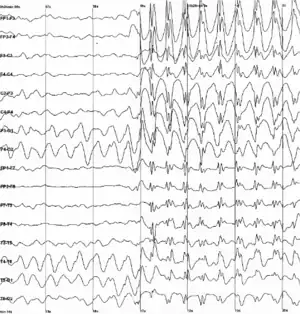癲癇發作
癲癇發作(,;有時在文獻或新聞簡稱 ,)是脑内异常“过度或同步”的神经元活动,而导致一段时间的症状[1][2]。這種腦內異常的外溢效應(outward effect)可以是無法自行控制的混亂運動,也可以是短暫的失去意識。任何能引起癲癇發作的腦部疾病或损伤,統稱癲癇(epilepsy)或癫痫症[2][1]。
| 癲癇發作 Epileptic seizure | |
|---|---|
| 同义词 | Epileptic fit, seizure, fit |
 | |
| 兒童失神性癲癇患者的腦電波釋放出的3赫茲棘徐波 | |
| 分类和外部资源 | |
| 醫學專科 | 神經內科 |
| ICD-10 | G40、P90、R56 |
| DiseasesDB | 19011 |
| MedlinePlus | 003200 |
| eMedicine | 1184846、1609294 |
癲癇發作可能發生在沒有癲癇歷史的人身上。危險因子包括:腦部创伤、濫用藥物[3]、過高體溫、低血糖 和缺氧。另外有一些看起來像癲癇發作的症狀,但實際上並非真的癲癇發作。
首次出現的癲癇發作通常不需要長時間服用抗癲癇藥,除非出現特定問題或要照腦電圖或腦部造影(brain imaging)[4]。
所有活到80歲的人之中大約 5~10%,在其人生中至少遇過一次癲癇發作,遇到第二次癲癇發作的機率介於 40~50% 之間 [4][5]。
備註
參考資料
- Fisher RS, Acevedo C, Arzimanoglou A, et al. . Epilepsia. April 2014, 55 (4): 475–482. PMID 24730690. S2CID 35958237. doi:10.1111/epi.12550. (原始内容存档于2020-07-31).
- Fisher R, van Emde Boas W, Blume W, et al. . Epilepsia. 2005, 46 (4): 470–2 [2021-10-08]. PMID 15816939. doi:10.1111/j.0013-9580.2005.66104.x. (原始内容存档于2021-10-20) (英语).
- Revesz, Rachael. . 獨立報. 2017-09-12 [2017-11-19]. (原始内容存档于2020-07-10) (英语).
- Wilden, JA; Cohen-Gadol, AA. . American family physician. Aug 15, 2012, 86 (4): 334–40. PMID 22963022.
- Berg, AT. . Epilepsia. 2008,. 49 Suppl 1: 13–8. PMID 18184149. doi:10.1111/j.1528-1167.2008.01444.x.
- Shearer, Peter. . Emergency Medicine Practice. [2017-07-23]. (原始内容存档于2010-12-30).
- National Institute for Health and Clinical Excellence. . (PDF). National Clinical Guideline Centre. January 2012: 21–28 [2017-07-23]. (原始内容存档 (PDF)于2013-12-16).
This article is issued from Wikipedia. The text is licensed under Creative Commons - Attribution - Sharealike. Additional terms may apply for the media files.